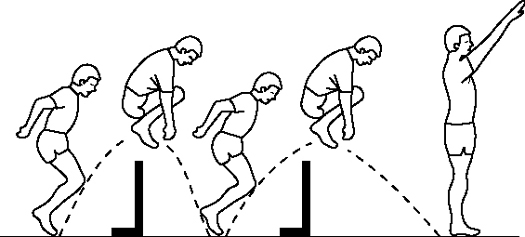Preparation for Plyometric Training
Plyometric exercises should be undertaken only once an adequate strength base has
been developed. Most sources define an adequate strength base for lower body plyometrics
as the ability to squat or leg press 1.5 to 2.0 times your body weight for one maximum
repetition. For upper body plyometrics, larger athletes (weight greater than 115 kg or 250
lbs.) should be able to bench press their body weight and athletes weighing less than 115
kg (250 lbs) should be able to bench press 1.5 times their body weight.
Plyometric training should never be undertaken if you
have any leg, hip, arm, or shoulder injury.
Recommended shoes are those that provide ankle and arch support, lateral stability,
and have a wide, non-slip sole.
Plyometric exercises should be undertaken only once an adequate strength base has
been developed. Most sources define an adequate strength base for lower body plyometrics
as the ability to squat or leg press 1.5 to 2.0 times your body weight for one maximum
repetition. For upper body plyometrics, larger athletes (weight greater than 115 kg or 250
lbs.) should be able to bench press their body weight and athletes weighing less than 115
kg (250 lbs) should be able to bench press 1.5 times their body weight.
Plyometric training should never be undertaken if you
have any leg, hip, arm, or shoulder injury.
Safety in Plyometric Training
Several steps can be taken to ensure that plyometrics training is safe. These
measures include using an appropriate surface, footwear, and equipment, and proper
technique.
measures include using an appropriate surface, footwear, and equipment, and proper
technique.
Surface
Plyometrics should not be performed on hard surfaces such as concrete or steel, nor
should they be performed on soft surfaces such as sand. The best surface is a grass
field, followed by artificial turf or wrestling mats. Wrestling mats should not be
too thick (> 15 cm) since they will increase the time in the amortization phase. The stored
energy gained during the lengthening phase will be lost, and this will defeat the purpose of
plyometric training.
should they be performed on soft surfaces such as sand. The best surface is a grass
field, followed by artificial turf or wrestling mats. Wrestling mats should not be
too thick (> 15 cm) since they will increase the time in the amortization phase. The stored
energy gained during the lengthening phase will be lost, and this will defeat the purpose of
plyometric training.
Footwear
Recommended shoes are those that provide ankle and arch support, lateral stability,
and have a wide, non-slip sole.
Equipment
Boxes that are used for in-depth or box jumps should have a non-slip top and should
never exceed a height of 1.2 m (0.5 - 0.75 m is recommended: 1.5 to 2.5 ft. and less than 4
ft.).
Medicine balls are commonly used for many of the exercises. This is a ball that
weighs no more than 10% of your typical training weight. For example, if you regularly
train with a 200 pound bench press, then the medicine ball you use should be no more than
20 lbs. These balls can be covered with leather, plastic, rubber, or any type of fabric.
never exceed a height of 1.2 m (0.5 - 0.75 m is recommended: 1.5 to 2.5 ft. and less than 4
ft.).
Medicine balls are commonly used for many of the exercises. This is a ball that
weighs no more than 10% of your typical training weight. For example, if you regularly
train with a 200 pound bench press, then the medicine ball you use should be no more than
20 lbs. These balls can be covered with leather, plastic, rubber, or any type of fabric.
Technique
As with other exercises, attention should be paid to proper technique. For example,
when performing lunges, the knee angle should not exceed 90°. Any movement beyond
this angle will place undue stress on knee cartilage and ligaments. Keeping the knee
directly over and in line with the big toe will help maintain technique. The step should be
straight out, not to the side. The shoulders should always be over the knees during landing
when performing in-depth jumps.
Fatigue from high-volume training can compromise technique and result in injury.
When technique begins to fail, it is time to stop the exercise and rest.
when performing lunges, the knee angle should not exceed 90°. Any movement beyond
this angle will place undue stress on knee cartilage and ligaments. Keeping the knee
directly over and in line with the big toe will help maintain technique. The step should be
straight out, not to the side. The shoulders should always be over the knees during landing
when performing in-depth jumps.
Fatigue from high-volume training can compromise technique and result in injury.
When technique begins to fail, it is time to stop the exercise and rest.


